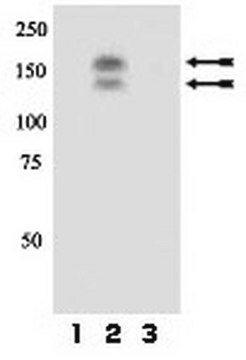05-481
Anti-phospho-MAP Kinase1/2 Antibody
clone 12D4, Upstate®, from mouse
Sinónimos:
Extracellular signal-regulated kinase, Insulin-stimulated MAP2 kinase, MAP kinase 1, MAPK 1, Microtubule-associated protein 2 kinase, extracellular signal-related kinase 1, mitogen-activated protein kinase 3
About This Item
Productos recomendados
biological source
mouse
Quality Level
antibody form
purified immunoglobulin
antibody product type
primary antibodies
clone
12D4, monoclonal
species reactivity
avian, rat, mouse, canine, human
manufacturer/tradename
Upstate®
technique(s)
ELISA: suitable
immunocytochemistry: suitable
immunohistochemistry: suitable
immunoprecipitation (IP): suitable
western blot: suitable
isotype
IgG1κ
UniProt accession no.
shipped in
wet ice
target post-translational modification
phosphorylation (pThr202/pTyr204)
Gene Information
human ... MAPK1(5594)
General description
Specificity
Immunogen
Application
Signaling
MAP Kinases
Quality
Western Blot Analysis: 0.1-1.0 μg/mL of this antibody detected phospho-MAPK in RIPA lysates from EGFstimulated human A431 carcinoma cells.
Target description
Physical form
Reconstitute with 1 mL H2O (15 min, RT) for a final concentration of 100 μg/mL.
Storage and Stability
Analysis Note
Positive Antigen Control: Catalog #12-302, EGF-stimulated A431 cell lysate. Add 2.5µL of 2-mercaptoethanol/100µL of lysate and boil for 5 minutes to reduce the preparation. Load 20µg of reduced lysate per lane for minigels.
Other Notes
Legal Information
Disclaimer
Not finding the right product?
Try our Herramienta de selección de productos.
Certificados de análisis (COA)
Busque Certificados de análisis (COA) introduciendo el número de lote del producto. Los números de lote se encuentran en la etiqueta del producto después de las palabras «Lot» o «Batch»
¿Ya tiene este producto?
Encuentre la documentación para los productos que ha comprado recientemente en la Biblioteca de documentos.
Nuestro equipo de científicos tiene experiencia en todas las áreas de investigación: Ciencias de la vida, Ciencia de los materiales, Síntesis química, Cromatografía, Analítica y muchas otras.
Póngase en contacto con el Servicio técnico





